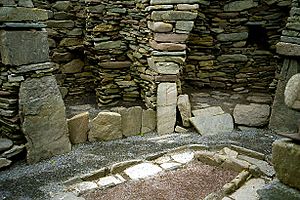Wheelhouse (archaeology) facts for kids


A wheelhouse is a special kind of ancient building. It was built in Scotland during the Iron Age. This was a time long, long ago, before written history. People first used the name "wheelhouse" in 1855. This was after they found a ruined mound.
These unique buildings were important homes. They were a main type of settlement in the Western Isles. This was around the last few centuries BC. Today, we know of 62 wheelhouse sites. You can find them in the Northern and Western Isles. They are also on the north coast of Caithness and Sutherland.
Contents
Discovering Wheelhouses
People started digging up these sites in the 1800s. But these early digs were done by amateurs. Professional archaeologists began studying them later. This started in the 1930s. Important digs happened at Jarlshof and Gurness. Modern archaeological work in the Hebrides began in 1946. This was at a site called Clettreval on North Uist.
What Does a Wheelhouse Look Like?
Wheelhouses are sometimes called "aisled roundhouses". They have a special design. Inside an outer wall, there's a circle of stone pillars. These pillars look like the spokes of a wheel. They support stone arches. These arches held up a corbelled roof. This roof was made of stones stacked inward. There was a fireplace in the middle, like the hub of a wheel.
About one-third of wheelhouses have double walls. They can be from 4 to 11.5 meters wide. Most of the dated wheelhouses were built between 25 BC and 380 AD.
In the Northern Isles, many wheelhouses are found near broch sites. Brochs are tall, round towers. Wheelhouses were built after these towers. But in the west, wheelhouses are not found with brochs. No one knows why this is different.
Most wheelhouses were dug into the ground. Only their thatched roofs would have been seen. These roofs could be 6 meters or taller! Other wheelhouses were built above ground. Examples include Clettraval and Bagh nam Feadag on Grimsay.
What Were Wheelhouses Used For?
Many wheelhouse sites have animal bones buried under the floor. Most often, these are bones of young lambs. Other bone finds include a human head and a great auk head. These were found at Cnip on the Isle of Lewis. At Sollas in North Uist, 60 bones were found. These included cattle, sheep, and pig bones.
Some sites also have menhirs, which are standing stones. Many sites used a special red and black mortar. These clues suggest that wheelhouses might have been used for ceremonies. So, "wheelhouses" might not have been just houses. They could have been places for important rituals.
Where Were Wheelhouses Found?
Wheelhouses are found in very specific areas. This suggests they might have been within a certain cultural area. Or maybe they were inside a political border. Their appearance and disappearance happened around the time of Roman influence in Scotland. Experts are still discussing if these events are connected.
See also

